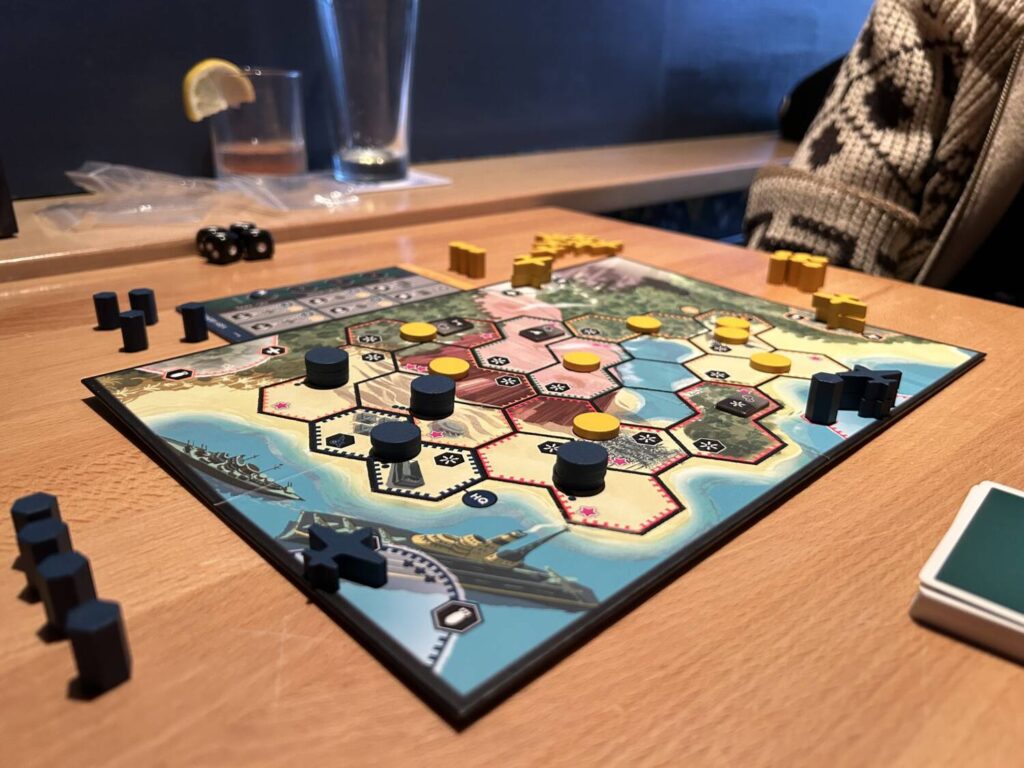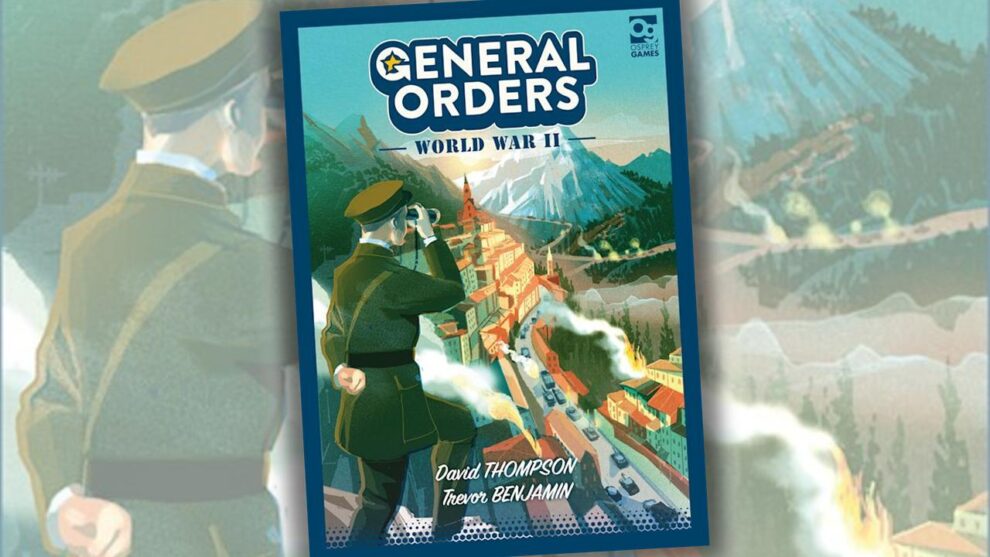Disclosure: Meeple Mountain received a free copy of this product in exchange for an honest, unbiased review. This review is not intended to be an endorsement.
For me, General Orders: World War II was a highly anticipated design, authored as it was by the dynamic duo of David Thompson and Trevor Benjamin (Undaunted, War Chest). My interest increased as more information came out. A light wargame that takes thirty minutes to play and uses worker placement? No need to draft me, I volunteer!
I was not expecting the box to be so tiny. Well, “tiny” is an overstatement. It’s deep, approaching equilateral cube, but the length and width are surprisingly and endearingly petite. Then you open it, and inside is the tiniest li’l quarter-fold board. This must be how Shaq feels when he plays Concordia. I’m worried I’ll break it. I feel some sort of primal drive to protect this board, to feed it milk from a bottle until it’s strong enough to make it out in the wild.
What I mean to say is, this may be the tiniest quarter-fold board I’ve ever seen. Usually, at this size, they don’t bother folding them.

Deployment
A game of General Orders is divided into four rounds, which follow standard worker placement conventions. Taking turns, each player places one Commander on an available action space in order to perform the action indicated. While the exact array of actions available changes depending on which of the two board sides you use, the gist is consistent: you can fire artillery, advance units, add reinforcements to the board, or draw cards from the Operations Deck.
Most of the action spaces are on the main board, in the regions that dot the landscape. If you want to fire artillery, for example, you place one of your Commanders on the artillery space in your color. In order to fire, you must not only control the region containing the icon, you must also have an unbroken line of controlled regions that lead back to your HQ.
General Orders is big on supply lines. You can’t even move troops unless they have a connection all the way back to base. To Advance, the Commander goes on the Advance space in the region you’re targeting. There’s only one per region, which creates a terrific sense of timing. If I move into a region, you’re unlikely to be able to challenge me for it until next round.
Combat is triggered automatically any time both sides have units in the same space. The defender, the player who was there first, rolls a defense die, which removes anywhere between 0 and 2 attacking units. After that, both sides remove one token at a time until only one side has anything left. Military victories in General Orders are hard-won, and never to be taken for granted.
Adding reinforcements and drawing cards are done via the action sideboard, meaning neither action can become unavailable to you. The first player to reinforce gets to add more troops than the second, and one of the two card draw options also gives you the initiative for the next round, but neither player can use both slots for either action in a single turn.
The game ends when either one player captures their opponent’s HQ, which results in instant victory for the aggressor, or after four rounds, at which point each player adds up the value of the territories they control.

Operation
The Operations Cards will likely play a big part in how much you do or don’t enjoy General Orders. Every card in the deck modifies an available action, giving you an offensive or defensive bonus. On paper, their effects are minimal, but the impact can be significant. This is a game in which one extra troop or one extra die roll can make all the difference.
I enjoy the tension of not knowing what cards your opponent has, and that’s made all the more interesting by the relative paucity of the card economy. On my third or fourth play, I was still discovering new cards I didn’t know were there.
The other thing you may or may not like? During setup, bonus tiles are set out into each space along the middle parallel of the board. The player who controls each of those receives a small bonus. In my plays thus far, one or two of the bonus abilities seem clutch enough that they can decide the game. An aggressive player who makes all the right calls might find success dealing with an opponent who has an extra Commander each turn, but I’ve yet to see that.
Shore Leave
I wanted to love General Orders, and I ended up liking it. We were hoping for an A and we got a B. That’s not so bad. It’s a design I appreciate more than I enjoy, which is not something I’ve ever said about either designer’s work in the past, either alone or together. The tradeoffs inherent to your decisions are there, and I can see them, but they don’t quite percolate into an exciting game. Not for me, at any rate.
That may be a product of the game’s brevity. There are relatively few exchanges in General Orders, because you don’t have the time or the resources to get carried away. You don’t feel constrained by the game, but changes in control are consequential. Every time you or your opponent make a move to take a space from the other player, the outcome is going to matter.
Even if General Orders hasn’t quite connected with me, there’s a lot to love here, and I suspect it would be a big hit with players who are predisposed towards the genre. There aren’t a whole lot of good two-player worker-placement games, and if you’re looking for one that’s newer than 2012’s Agricola: All Creatures Big and Small, General Orders: WWII will do you just fine. The variety in Operations Cards, combined with the double-sided board with two scenarios, means that they’ve packed a surprising amount of game into that itty bitty box.











Add Comment